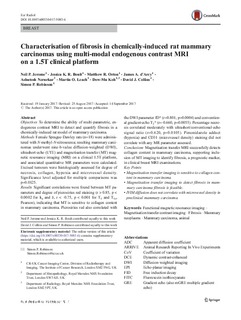Characterisation of fibrosis in chemically-induced rat mammary carcinomas using multi-modal endogenous contrast MRI on a 1.5T clinical platform
| dc.contributor.author | Jerome, Neil Peter | |
| dc.contributor.author | Boult, Jessica | |
| dc.contributor.author | Orton, Matthew R | |
| dc.contributor.author | d'Arcy, James | |
| dc.contributor.author | Nerurkar, Ashutosh | |
| dc.contributor.author | Leach, Martin O | |
| dc.contributor.author | Koh, Dow-Mu | |
| dc.contributor.author | Collins, David J. | |
| dc.contributor.author | Robinson, Simon | |
| dc.date.accessioned | 2019-08-07T13:00:44Z | |
| dc.date.available | 2019-08-07T13:00:44Z | |
| dc.date.created | 2019-07-25T17:42:33Z | |
| dc.date.issued | 2018 | |
| dc.identifier.issn | 0938-7994 | |
| dc.identifier.uri | http://hdl.handle.net/11250/2607479 | |
| dc.description.abstract | Objectives To determine the ability of multi-parametric, endogenous contrast MRI to detect and quantify fibrosis in a chemically-induced rat model of mammary carcinoma. Methods Female Sprague-Dawley rats (n=18) were administered with N-methyl-N-nitrosourea; resulting mammary carcinomas underwent nine-b-value diffusion-weighted (DWI), ultrashort-echo (UTE) and magnetisation transfer (MT) magnetic resonance imaging (MRI) on a clinical 1.5T platform, and associated quantitative MR parameters were calculated. Excised tumours were histologically assessed for degree of necrosis, collagen, hypoxia and microvessel density. Significance level adjusted for multiple comparisons was p=0.0125. Results Significant correlations were found between MT parameters and degree of picrosirius red staining (r > 0.85, p < 0.0002 for ka and δ, r < -0.75, p < 0.001 for T1 and T1s, Pearson), indicating that MT is sensitive to collagen content in mammary carcinoma. Picrosirius red also correlated with the DWI parameter fD* (r=0.801, p=0.0004) and conventional gradient-echo T2* (r=-0.660, p=0.0055). Percentage necrosis correlated moderately with ultrashort/conventional-echo signal ratio (r=0.620, p=0.0105). Pimonidazole adduct (hypoxia) and CD31 (microvessel density) staining did not correlate with any MR parameter assessed. Conclusions Magnetisation transfer MRI successfully detects collagen content in mammary carcinoma, supporting inclusion of MT imaging to identify fibrosis, a prognostic marker, in clinical breast MRI examinations. | nb_NO |
| dc.language.iso | eng | nb_NO |
| dc.publisher | Springer Verlag | nb_NO |
| dc.rights | Navngivelse 4.0 Internasjonal | * |
| dc.rights.uri | http://creativecommons.org/licenses/by/4.0/deed.no | * |
| dc.title | Characterisation of fibrosis in chemically-induced rat mammary carcinomas using multi-modal endogenous contrast MRI on a 1.5T clinical platform | nb_NO |
| dc.type | Journal article | nb_NO |
| dc.type | Peer reviewed | nb_NO |
| dc.description.version | publishedVersion | nb_NO |
| dc.source.journal | European Radiology | nb_NO |
| dc.identifier.doi | 10.1007/s00330-017-5083-6 | |
| dc.identifier.cristin | 1712763 | |
| dc.description.localcode | © The Author(s) 2017 Open Access This article is distributed under the terms of the Creative Commons Attribution 4.0 International License (http://creativecommons.org/licenses/by/4.0/) | nb_NO |
| cristin.unitcode | 194,65,25,0 | |
| cristin.unitname | Institutt for sirkulasjon og bildediagnostikk | |
| cristin.ispublished | true | |
| cristin.fulltext | original | |
| cristin.qualitycode | 2 |

